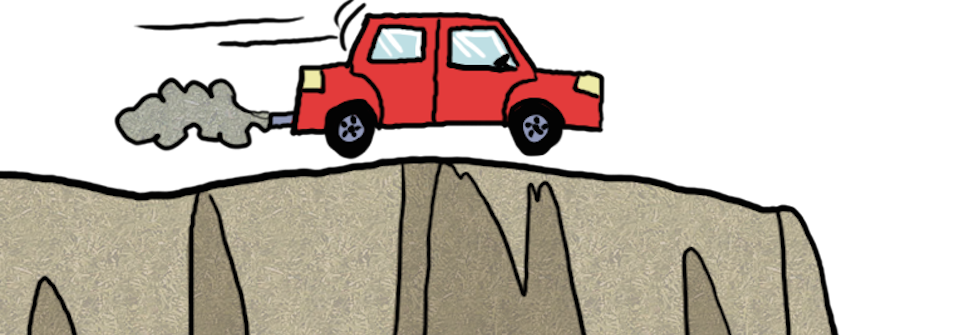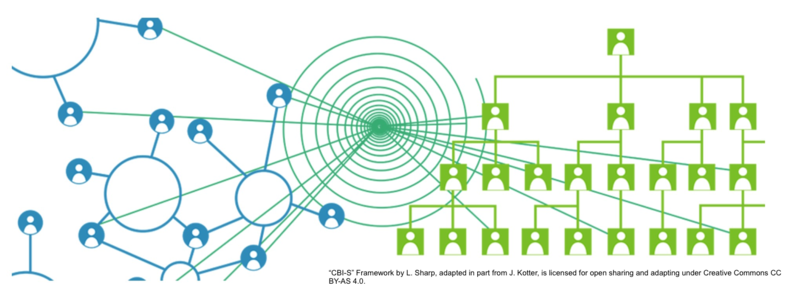Executive Education for Sustainability Leadership
Learn powerful new strategies for making sustainability a driver of organizational engagement, innovation, and change.
Department of Environmental Health, Harvard T.H. Chan School of Public Health
Put simply, we are in the wrong organizational vehicle for the 21st century

By Leith Sharp, Director of Executive Education for Sustainability Leadership, Center for Health and the Global Environment
I’ve been asking senior leaders this question: “Is there a clear path for a good idea to come from anywhere in your organization?” The general consensus is no, there is no clear path for a good idea to find its way forward from anywhere, not for universities, corporations, airports, government agencies, nor non-profits alike. There are some specific exceptions, but they are specific and they are exceptions. Instead the general agreement seems to be that the success of a good idea depends mostly on the sheer tenacity of its champion.
I’ve also been asking senior leaders, “Do you think management-driven hierarchy, or the command control operating system that predominates almost all sectors, is adequate for tackling a complex adaptive challenge like sustainability? Or is it adequate for tackling our other complex 21st century challenges?” No one is saying yes. Add to this anecdotal avalanche the empirical nugget that 70% of the US workforce is disengaged at work (Gallup State of the American Workplace Report 2013), and there you have it.
Nobody actually seems to think that our predominant mode of organizing is going to get us through this century effectively. Put simply, we are in the wrong organizational vehicle for the 21st century.
This is big news. It begs the question for the sustainability-minded, why are we all still running around the deck of this sinking ship, tossing out water and trying to change direction, when the ship itself might be our most immediate problem? One of the biggest reasons, of course, is that if we are going to talk about the deep work of organizational transformation, then we must have the involvement of enough senior leaders. Otherwise, it’s great dinner conversation, but there is no sleeve rolling come Monday. Senior leadership engagement around sustainability has been hard to stir up in any consistent way and the bandwidth senior leaders have dedicated to it has often been consumed by low impact leadership.
Senior Leadership Bandwidth Must Be Directed Towards High Impact Sustainability Leadership
To use Ron Heifetz’s highly effective dance floor and balcony metaphor for adaptive leadership, it seems that sustainability has been so new that we’ve collectively stayed on the dance floor, in the midst of the action. We haven’t found the sustainability balcony to perceive the bigger picture and the patterns. One result of this is that senior leaders have been peppered with individual sustainability battles, little victories and incremental goals towards doing less bad. As a result, many leaders have sensed in sustainability a bottomless pit of need that fills them with dread.
But that dread goes away as senior leaders find their way up onto the balcony to check out the dance floor action from above. From here they can see a way to lead within the constraints of their own bandwidth that will have lasting and expansive impact. There is a sense of liberation and possibility.
From this higher-level vantage point, it becomes possible to see how the right kind of sustainability leadership can transform an organization into an agile, innovative, and profoundly change-capable enterprise with the fitness to go beyond simply doing less bad towards a mutually regenerative relationship with our planetary life support systems.
Along with this new fitness comes the enormous value proposition of making other complex adaptive problems easier to solve as well. After all, sustainability is the ultimate complex adaptive problem, so developing the right organizational fitness to truly take on the sustainability triathlon (social, economic and environmental) pretty much guarantees relevant fitness for all of our other adaptive problems. Viewed and lead from the right elevation, sustainability is the problem that can solve your organization.
It’s Not About Throwing Out Command Control, It’s About Complementing It
To be clear, the sustainability balcony does not confer a spontaneous altered state of consciousness upon those that stand on it. Senior leaders remain understandably hesitant to explore uprooting the command control systems and structures on which their organization relies. But a significant number of leaders will entertain the idea of creating a second complementary operating system, an adaptive operating system, that can be harmonized with command control to bring about a new era of organizational engagement, agility and change-capability so that large numbers of good ideas can come from anywhere and take root, continuously and stably.

Defining Core Business Innovation for Sustainability (CBI-S)
The commitment to go beyond treating sustainability as an add-on and settling for doing less bad. It’s about taking up the qualitatively different leadership challenge of driving sustainability into the core mission and business of the organization by unleashing the profound motivational force that is sustainability and ensuring there are productive ongoing pathways for its full ongoing expression. A high-impact sustinability leader positions sustainability as a driver of organizational transformation to advance engagement, agility, systems-thinking, change-capability and innovation. The organization integrates and harmonizes adaptive cycles of engagement, collaboration and applied learning with command and control routines of scaling, execution and accountability. In summary, these frameworks transform or re-invent organizations to unleash the full potential of people to address complex adaptive problems.
Six Common Reactions to these Big Ideas
In the last 9 months we’ve shared these big ideas with over 500 senior leaders and sustainability professionals from different sectors at a variety of different conferences and workshops. Here is a short list of commonly observed reactions:
- Most leaders are relieved that instead of proposing the end of command control we are proposing the integration of the two operating systems.
- There is a widely shared intuitive understanding of the adaptive operating system (left in diagram), its potential & importance.
- Leaders who have been leading in this direction have been going it alone, intuitively & without a shared language or shared understanding.
- There is enthusiasm for using the language, graphics & framework to help make organizational transformation more of a team sport.
- Leaders are quick to identify the larger value proposition as being agnostic and applicable to other complex adaptive problems.
- Leaders affirm this framework will be best learned through applied exploration, ideally in the company of other senior leaders on the same path. To this end, there is agreement that sustainability is a very fertile laboratory for this applied organizational transformation process.
Aspects of This Are Not New in the Sustainability Space
Sustainability professionals exposed to this conversation are noting that the most successful sustainability efforts within large organizations have exhibited a recurring theme of the emergence of the adaptive operating system along with a Shakespearean-like struggle to integrate it with the existing command control operating system. The Shakespearean dimensions are generally shared over about the third drink as such riveting tales of heroism, tragedy and farce that one wonders why a sitcom hasn’t come out of it yet.
Sustainability professionals have also noted that their struggles have been greatly compounded by being without a shared language or shared understanding around the work of transforming organizational systems, processes and structures. They also agree that having this will be a game changer, effectively enabling change leadership for sustainability to advance from amateur sport to professional sport.
We Need An Army of High Impact Sustainability Leaders
We need large numbers of senior leaders and sustainability professionals from all sectors to become high impact sustainability leaders engaged in applied CBI-S experimentation and shared learning.
One powerful on ramp for anyone ready to engage in this critical leadership work can be found in the form of Harvard’s selective 4-day Executive Education for Sustainability Leadership programs. This program is designed for senior leaders and sustainability professionals from all sectors and is delivered by Harvard’s Center for Climate, Health and the Global Environment at the Harvard T.H. Chan School of Public Health.
We hope you can make it to Harvard but if not, stay tuned as the network of leaders, conveners and offerings grows. Stay connected by signing up for our mailing list.
Leith Sharp is the lead faculty and program director of Executive Education for Sustainability Leadership at The Center for Climate, Health and the Global Environment at the Harvard T.H. Chan School of Public Health.
Date Created:
April 2, 2015